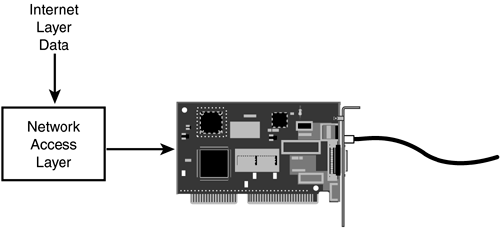Anatomy of a Frame
The Network Access layer software accepts a datagram from the Internet layer and converts that data to a form that is consistent with the specifications of the physical network (see Figure 3.2). Because many forms of physical networks exist, there are many formats for data at the Network Access layer, and it would not be easy or useful to describe all these formats in detail.

As an example of what happens to the data at the Network Access layer, consider the case of ethernet, the most common of the LAN architectures. When the ethernet software receives a datagram from the Internet layer, it performs the following steps:
Breaks IP layer data into smaller chunks, if necessary, which will be sent in the data field of the ethernet frames. The total size of the ethernet frame must be between 64 bytes and 1,518 bytes (not including the preamble). Packages the chunks of data into frames. Each frame includes data as well as other information that the network adapters on the ethernet need to process the frame. An IEEE 802.3 ethernet frame includes the following:
Preamble:
A sequence of bits used to mark the beginning of the frame (8 bytes, the last of which is the 1-byte Start Frame Delimiter).
Recipient address:
The 6-byte (48-bit) physical address of the network adapter that is to receive the frame.
Source address:
The 6-byte (48-bit) physical address of the network adapter that is sending the frame.
Length:
A 2-byte (16-bit) field indicating the size of the data field.
Data:
The data that is transmitted with the frame.
Frame Check Sequence (FCS):
A 4-byte (32-bit) checksum value for the frame. The FCS is a common means of verifying data transmissions. The sending computer calculates a Cyclical Redundancy Check (CRC) value for the frame and encodes the CRC value in the frame. The receiving computer then recalculates the CRC and checks the FCS field to see whether the values match. If the values don't match, some data was lost or changed during transmission, in which case the frame is retransmitted. Passes the data frame to lower-level components corresponding to OSI's physical layer, which will convert the frame into a bitstream and send it over the transmission medium.
The other network adapters on the ethernet receive the frame and check the destination address. If the destination address matches the address of the network adapter, the adapter software processes the incoming frame and passes the data to higher layers of the protocol stack.
By the Way
IEEE 802.3 is not the only ethernet standard. The Ethernet II standard, used by some vendors, has a slightly different frame format.
|
 Source code editor
Website development
Source code editor
Website development
 Source code editor
Website development
Source code editor
Website development